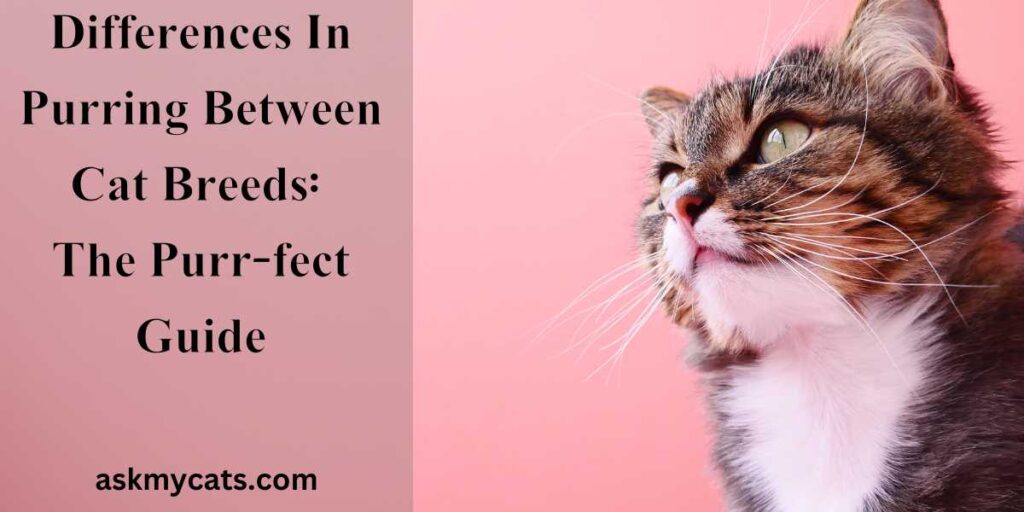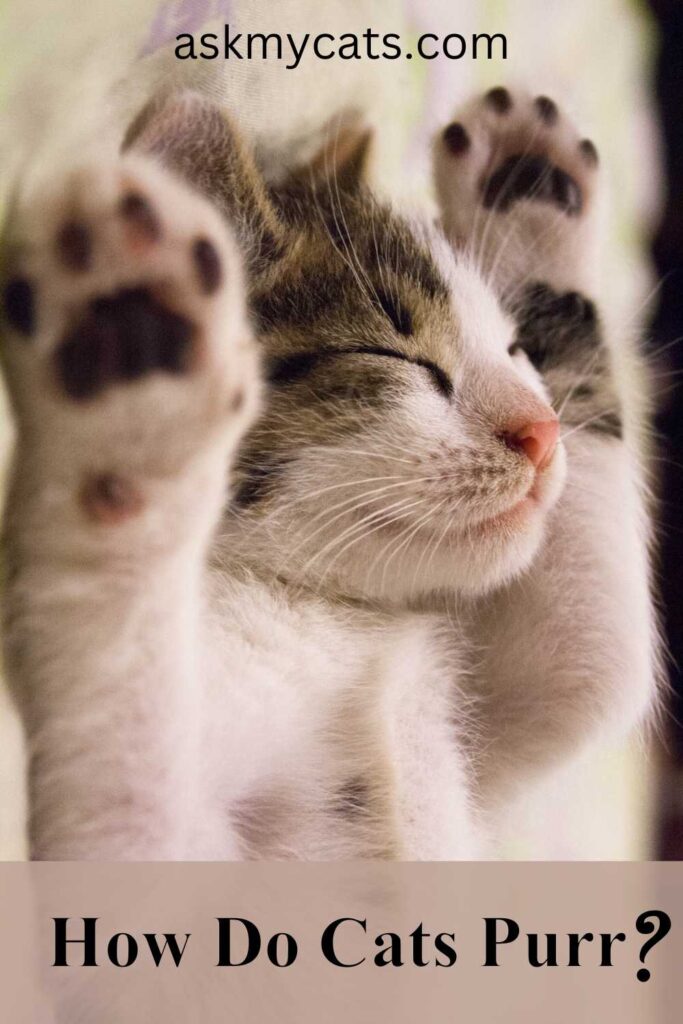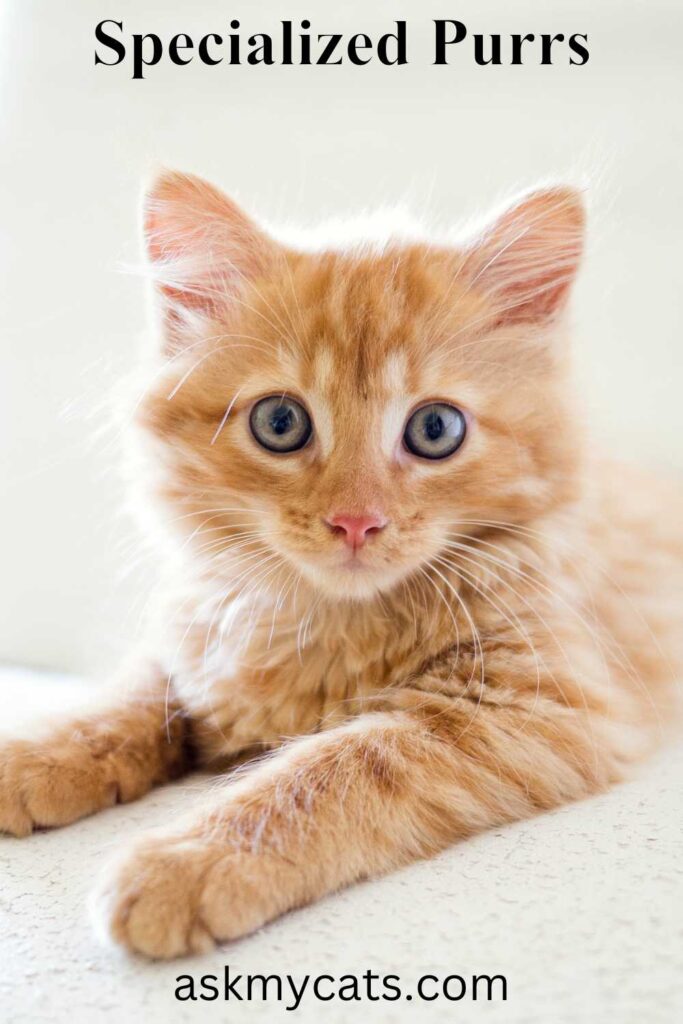Hey, there fellow cat lovers! Have you ever noticed that different cat breeds purr differently? Well, you’re not alone. I’ve been a cat mom for years and I’ve always been fascinated by the different purring styles of my furry friends.
From the low, rumbly purrs of Maine Coons to the high-pitched trills of Siamese cats, each breed has its own unique purring characteristics.
But why is this? Is it just a matter of preference or is there something more to it? As it turns out, there’s a scientific explanation behind the differences in purring between cat breeds. And let me tell you, it’s pretty darn interesting!
One theory suggests that the size and shape of a cat’s skull play a role in the type of purr they produce. Another theory points to the thickness of a cat’s vocal cords. But whatever the reason, it’s clear that there’s more to a cat’s purr than meets the ear.
So, if you’re as curious as I am about the purring habits of different cat breeds, keep reading. I’ve done some research and I’m excited to share all the details with you.
Trust me, you won’t want to miss it!
Key Takeaways
- Different cat breeds have distinct purring patterns and frequencies, which can be attributed to the size and genetics of the breed.
- Larger breeds like the Maine Coon have larger vocal cords, which results in a lower frequency purr.
- Smaller breeds like the Siamese have smaller vocal cords, which results in a higher frequency purr.


Give Your Cat the Perfect Day
Get the Free Ebook!
How Do Cats Purr?
Cat experts believe that there is no particular biological feature that is responsible for the vocal characteristic of purring. Purring is a unique feature exclusive to domestic cats. It is seen in a few species of the Felidae family, however, the Patherinae subfamily members do not demonstrate this vocal characteristic.

Kittens begin to purr when they are a few weeks old. Vets suggest that it acts as a mechanism for them to interact with their mothers.
Earlier, it was believed that purring was a result of the blood surging through the inferior vena cava or produced by a separate voice box.
However, recent research advocates that the internal laryngeal muscles are the probable source. This is proven by the fact that there is an absence of purring in cats with laryngeal paralysis.
Studies suggest that the vocal cords in a cat’s throat vibrate due to the muscles present and as the cat inhales and exhales, the air hit these vibrating muscles, emanating the purring sound.
The Library Of Congress explains it as follows “The laryngeal muscles are responsible for the opening and closing of the glottis (space between the vocal cords), which results in a separation of the vocal cords, and thus the purring sound.”
Interesting Read: Why Is My Cat Purring So Much?
Specialized Purrs

You will often find that not all cat species purr. Generally, cat purring is reserved for small and domestic cats. Let’s explore these differences in purring between cat species.
1. Purring and Roaring
In ancient times, it was believed that a distinction could be made between two types of cats – those who purr and those who don’t.
According to Wired “ Early 19th century, taxonomists thought cats could either purr or roar, and split the family Felidae along these lines—”purrers’ (subfamily Felinae) and ‘roarers’ (subfamily Pantherinae).”
Hence, in general, only small cats purr while big cats like lions, roar instead. Tigers have a very low purr that is almost indiscernible at the normal hearing range. The Spruce pets believe that this sound is capable of briefly paralyzing the tiger’s prey.
2. Growling and Hissing
All types of cats, large and small, have the inherent potential to growl and hiss to an extent. As you may have guessed, both are not particularly happy sounds. They are made in anger or frustration. Cats growl when they feel endangered or threatened or when they wish to stake their claim over something or someone.
Hissing is usually a last warning before a full-throttle attack.
3. Chuffing
Chuffing can be best described as a domestic cat’s purring.
According to Carnegiemnh,” Tigers, Jaguars, Snow Leopards, and Clouded Leopard’s chuff. It is often used between two cats as a greeting, during courting, or by a mother comforting her cubs. Chuffing is always used as a non-aggressive signal and helps to strengthen social bonds.”
Interesting Read: Cat Purring Effect On Humans
Differences in Purring Between Cat Breeds
I was always fascinated by the purring of my cats. The soothing sound they make while they’re curled up next to me on the couch is one of my favorite things in the world.
But did you know that not all cats purr the same way? That’s right, the purring of different cat breeds can vary quite a bit.
Purring Patterns
First, let’s start with the basics. All cats purr, but did you know that the purring patterns can vary between breeds?
According to Dr. Elizabeth von Muggenthaler, a leading expert in bioacoustics, “Different cat breeds have distinct purring patterns and frequencies, much like different human cultures have distinct languages.”
Dr. Elizabeth von Muggenthaler
For example, Siamese cats have a higher frequency purr, while Maine Coon cats have a lower frequency purr. These variations in purring patterns can be attributed to the size and genetics of the breed.
Dr. von Muggenthaler states, “Larger breeds like the Maine Coon have a lower frequency purr because their vocal cords are larger, while smaller breeds like the Siamese have a higher frequency purr because their vocal cords are smaller.”
Dr. Elizabeth von Muggenthaler
Frequency of Purring
But it’s not just the purring patterns that vary between breeds. The frequency of purring can also differ.
According to a study by the University of Sussex, “The average frequency of a domestic cat’s purr is around 25 Hz, but some breeds like the Siamese can purr at frequencies as high as 35 Hz.”
This is why Siamese cats are known for their “loud” purring, while other breeds like the Persian are known for their “quieter” purring. It’s not that they purr less, they just do it at a lower frequency.
Reasons for the Differences in Purring
So, why do these differences in purring patterns and frequencies exist?
Well, it all comes down to genetics and size.
Larger breeds like the Maine Coon have larger vocal cords, which results in a lower frequency purr. On the other hand, smaller breeds like the Siamese have smaller vocal cords, which results in a higher frequency purr.
But genetics also play a role. Different breeds have been developed over time through selective breeding, which has led to the development of specific traits, including purring habits.
Interesting Read: Why Does My Cat Lay On Me And Purr?
Popular Cat Breeds and Their Purring Habits
Now that we understand the science behind purring, let’s take a look at some of the most popular cat breeds and their purring habits.
| Cat Breed | Purring Habits |
|---|---|
| Siamese | Siamese cats are known for their loud, high-pitched purr. Their purr can reach frequencies as high as 35 Hz. |
| Maine Coon | Maine Coon cats have a lower frequency purr, which is attributed to their larger size. They also have a deep, rumbling purr that is quite unique. |
| Persian | Persians are known for their quiet, gentle purr. Their purr is typically at a lower frequency, around 20 Hz. |
| American Shorthair | American Shorthairs have a medium frequency purr, around 25 Hz. They are known for their soft, soothing purr. |
| Bengal | Bengal cats are known for their loud, chattering purr. They often make a variety of other vocalizations in addition to purring, such as chirping and trilling. |
| Sphynx | Sphynx cats are known for their unique, raspy purr. This is due to their hairless coats, which can make their purring more audible. |
| British Shorthair | British Shorthairs have a medium frequency purr, around 25 Hz. They are known for their soft, steady purr that can be quite soothing. |
| Scottish Fold | Scottish Folds have a medium frequency purr, around 25 Hz. They are known for their gentle, melodic purr that can be quite relaxing. |
| Abyssinian | Abyssinian cats have a higher frequency purr, around 30 Hz. They are known for their distinctive, chirping purr that can be quite charming. |
| Russian Blue | Russian Blue cats have a medium frequency purr, around 25 Hz. They are known for their soft, melodic purr that can be quite soothing. |
| Burmese | Burmese cats have a medium frequency purr, around 25 Hz. They are known for their steady, rhythmic purr that can be quite comforting. |
Special Note
Please note that these are generalizations and individual cats may have their own unique purring habits.
It’s also worth noting that some cats may purr more or less frequently than others, depending on their individual personalities and lifestyles. This can also affect the frequency and type of purring. Some cats may purr frequently and loudly, while others may only purr occasionally and quietly.
Interesting Read: Why Do Cats Purr When You Stroke/Pet Them?
Frequently Asked Questions
Can a cat’s purr change in pitch or volume?
Yes, a cat’s purr can change in pitch or volume depending on the cat’s emotional state. For example, a cat may purr louder or more rapidly when they are in pain or feeling stressed.
Why do some cats purr more than others?
The frequency and intensity of purring can vary between individual cats. Some cats may purr more frequently or more loudly than others. Factors such as breed, age, and personality can also play a role in the amount a cat purrs.
Final Thoughts
In a nutshell, there exists a difference in purring between cat breeds.
Not all cat species purr. Instead, they roar, growl, hiss, and chuff. This is especially true for big cats like lions, tigers, jaguars, and cheetahs.
This variation is caused by the larynx muscles that deviate amongst cats. They result in differences in shape, size, and frequency of purrs.
Some of the Interesting reads regarding cat purring:
- Why Do Cats Purr? The Science of Cat Purring
- Why Doesn’t My Cat Purr?
- How To Make A Cat Purr?
- Do Cats Purr When They Sleep?
- Why Does My Cat Purr So Loudly?
- Can Cats Control Their Purring?
- Do Cats Breathe Faster When Purring?
- Why Do Cats Wag Their Tails While Purring?
- How To Purr Like A Cat?
- Why Does My Cat’s Purring Sound Congested?
- Why Is My Pregnant Cat Purring So Much?
- Why Do Cats Purr And Knead?
- Do Cats Purr When They Are Happy?
- Why Do Cat’s Noses Get Wet When They Purr?
- Why Does My Cat Drool When He Purrs?
- Why Does My Cat Purr And Bite Me?
- Why Do Cats Purr When You Talk To Them?
